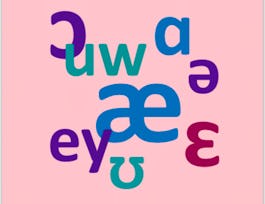In this course, you’ll practice the sounds of American English that might sometimes be confusing. You'll practice both consonant and vowel sounds. You’ll also learn about the things that give English its special “music,” such as how to stress the right syllable in a word, how to make your voice go up and down in a natural-sounding melody, and how to naturally connect sounds and words. Learning these things will help you speak more clearly and make sure that others can understand what you're saying.


Tricky American English Pronunciation
Taught in English
Some content may not be translated
250,519 already enrolled
(2,316 reviews)
Details to know

Add to your LinkedIn profile
16 quizzes
See how employees at top companies are mastering in-demand skills


Earn a career certificate
Add this credential to your LinkedIn profile, resume, or CV
Share it on social media and in your performance review

There are 5 modules in this course
In this course, you will learn about the consonant and vowel sounds of American English and practice some of the difficult sounds. You will also learn about and practice intonation and stress. Practicing these things will help you improve your pronunciation and make your speech easier for others to understand.
What's included
2 videos1 peer review
In this first week, you will practice the consonant sounds of American English. Consonants are the sounds where the air coming up from your lungs meets some obstacles on the way. The first sounds in the words time, sand, and moon are consonants. After a quick quiz to find out which consonant sounds are the most difficult for you, you’ll practice some pairs of sounds that might be confusing and learn some tricks for telling them apart, and you’ll start to understand how your mouth moves when you say these sounds.
What's included
9 videos8 readings4 quizzes1 peer review
This week, you’ll practice some tricky vowel sounds in American English. Vowels are sounds that come out of your mouth very smoothly, like the first sounds in apple, ocean, and out. Vowel sounds are very important for being understood in English. They’re the “heart” of each syllable, and they need to be said clearly to avoid misunderstanding. Our goal is to help you pronounce English in a way that can be easily understood by listeners in real life, and mastering vowel sounds is an important step toward that goal. Now let’s practice the vowel sounds of American English.
What's included
9 videos7 readings4 quizzes1 peer review
This week, you’ll learn about some things that give English its special rhythm and melody. You’ll learn about syllables—the small chunks of sound that make up the “beats” in words—and word stress—the way some parts of words are emphasized more than others. You’ll also see how some words become shorter and weaker when we talk. Since these words are used very often in ordinary speaking, we can’t understand spoken English without them. Our goal this week is to help you use the music of English to communicate more effectively and to be understood more easily when you speak. Enjoy learning about the music of American English pronunciation.
What's included
11 videos8 readings4 quizzes1 peer review
In this final week of the course, you'll look at a few more tricky points in American English pronunciation. First, you’ll learn about the different ways to pronounce the –s and –ed word endings, which have important grammatical meanings, and you’ll learn when to use each kind of pronunciation. Next, you’ll practice pronouncing numbers like 14 and 40, 15 and 50, 16 and 60 that can cause misunderstandings. You’ll also learn about the pronunciation of the words “can” and “can’t” –the difference between them might surprise you. Finally, you’ll practice some sound changes that happen when words come together in common spoken expressions like "gonna" for "going to," "wanna" for "want to," and "shoulda" for "should have."
What's included
8 videos8 readings4 quizzes1 peer review
Instructors


Offered by
Recommended if you're interested in Learning English

University of California, Irvine

University of California San Diego

University of California San Diego

University of California, Irvine
Why people choose Coursera for their career




Learner reviews
Showing 3 of 2316
2,316 reviews
- 5 stars
82.46%
- 4 stars
12.39%
- 3 stars
2.72%
- 2 stars
0.77%
- 1 star
1.64%

Open new doors with Coursera Plus
Unlimited access to 7,000+ world-class courses, hands-on projects, and job-ready certificate programs - all included in your subscription
Advance your career with an online degree
Earn a degree from world-class universities - 100% online
Join over 3,400 global companies that choose Coursera for Business
Upskill your employees to excel in the digital economy
Frequently asked questions
You will need a computer, smart phone, or other recording device to record your voice in .mp3 format for graded assignments.
Access to lectures and assignments depends on your type of enrollment. If you take a course in audit mode, you will be able to see most course materials for free. To access graded assignments and to earn a Certificate, you will need to purchase the Certificate experience, during or after your audit. If you don't see the audit option:
The course may not offer an audit option. You can try a Free Trial instead, or apply for Financial Aid.
The course may offer 'Full Course, No Certificate' instead. This option lets you see all course materials, submit required assessments, and get a final grade. This also means that you will not be able to purchase a Certificate experience.
When you purchase a Certificate you get access to all course materials, including graded assignments. Upon completing the course, your electronic Certificate will be added to your Accomplishments page - from there, you can print your Certificate or add it to your LinkedIn profile. If you only want to read and view the course content, you can audit the course for free.



